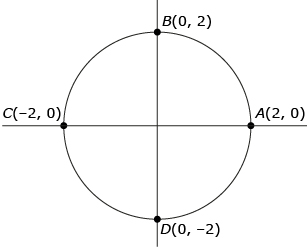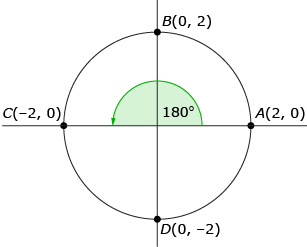Lesson 3
1. Lesson 3
1.1. Discover
Module 2: Trigonometry
Discover
Consider the following circle of radius 2 units.

One could imagine superimposing angles in standard position on top of this circle. For instance, this is what a 180° angle would look like:

Since you know the coordinates of a point on the terminal arm and the distance from that point to the origin (r), you can determine the cosine, sine, and tangent of 180° without technology by using the definitions introduced in Lesson 1.
 |
 |
 |
Try This 1
Use the definitions process to determine the cosine, sine, and tangent of the following angles.
| θ | cos θ | sin θ | tan θ |
| 0° | |||
| 90° | |||
| 180° | −1 | 0 | 0 |
270° |
|||
| 360° |
![]() Save your chart in your course folder.
Save your chart in your course folder.
Share 1
Compare your results with a partner.
- Discuss any differences and try to come to agreement on all values in the table.
- How would your values change if the circle had been drawn with a radius of 3 or with any other radius?
![]() If required, save a copy of your discussion in your course folder.
If required, save a copy of your discussion in your course folder.
The coordinates of the endpoint of the 270° angle's terminal arm are (0, −2).
Dividing by zero is not valid. Mathematicians say the result is undefined.